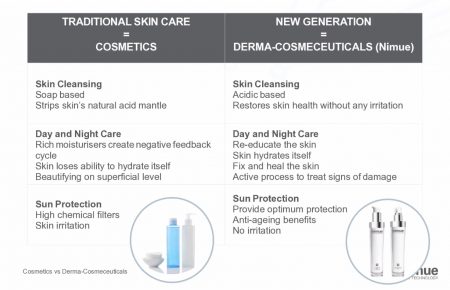COSMETIC V DERMA-COSMECEUTICAL PRODUCTS
WHAT’S THE DIFFERENCE?
Have you heard of Derma-Cosmeceuticals products? Do you know what they are and how do they differ from Cosmetic products?
We are all familiar with cosmetic products. These are the type of products that we can all buy over the counter from a range of high street shops. We don’t need any special knowledge to decide what to buy. We just self-diagnose and buy what we think will treat whatever issue it is that we are trying to correct, for example a moisturiser for dry skin.
Cosmetic products have a temporary affect on our skin, and are designed to soothe, hydrate, tighten or smooth the skin. Unfortunately, they can also cause something called the ‘Negative Feedback Cycle’.
The Negative Feedback Cycle occurs when we use cosmetic products on our skin. Our skin is inherently lazy, so if we apply a cosmetic moisturiser for dry skin, it sits more on the surface of our skin, and fools the skin into thinking it doesn’t need to produce it’s own oils and moisturiser, as there is now a product that’s been applied that is doing this job for it.
As a result of using this moisturiser, our skin actually produces less of it’s own oils and moisturiser, which means our skin actually feels dryer, and that’s when we then resort to purchasing a thicker, heavier moisturiser, and so the cycle continues.
Similarly, if we have an oilier skin, and we self prescribe a moisturiser for this skin type, these products tend to strip the skin of it’s own oils, water, moisturiser etc, and so the skin thinks that this element is now lacking, and so proceeds to produce even more.
The best way to treat our skin, is to educate it to produce it’s own oils, water, moisturiser, collagen etc rather than masking these issues with lots of rich products.
If we take a look at the traditional, cosmetic products that we use on our skin, these tend to be:
- Skin cleanser. These are traditionally soap based, and they tend to strip the skins own, natural, acid mantle. They tend to have a more alkaline pH, which disturbs the natural pH of the skin.This results in the skin being stripped, irritated, tight and dehydrated. Oily skin will experience even more oil production and breakouts. It takes the skin approximately 8 hours to repair itself after you use a product like this. Protection and a heathy acid mantle provides the skin with an ideal pH.
- Day and night care. Rich moisturisers create a negative feedback cycle. Skin loses ability to hydrate itself. These products are beautifying, but only on a superficial level.
- Sun protection. These tend to use high levels of chemical filters which can cause skin irritation.
Understanding your products
Products often refer to being pH balanced, but what does this actually mean? pH refers to potential of hydrogen ions. pH is a scale used to specify the acidity or alkalinity of an aqueous solution. Acidic solutions have a lower pH than alkaline solutions. The pH of a product directly affects skin health and quality. The natural pH of our skin is 4.5 – 5.75, so slightly acidic (pH is measured on a scale of 0-14, with 0 being acidic, 7 being neutral and 14 being alkaline).
The acidic nature of the skin is designed to protect it, hence the stripping of the acid mantle mentioned above, by using products of an incorrect pH, is damaging to the skin, and leaves it vulnerable to attack from outside influences.

What is the Acid Mantle?
The acid mantle is made up of combination of sebum and sweat that together produce an acidic substance on the surface of the skin, to ward off fungi and bacteria.
An alkaline product strips the skin of this acid mantle, leaving it tight, dehydrated and irritated.
Skin Barrier
We often liken our skin’s barrier to a brick wall. Ideally, our skin’s barrier will be strong and offer us protection from the outside world. Stripping the skin is akin to having a brick wall with crumbling mortar. This allows fungi and bacteria to enter the skin, which causes redness, irritation and dehydration, the complete opposite of what we are trying to achieve.


So, what are Derma-Cosmeceutical Products and how do they differ from Cosmetic Products?
Derma – Dermal/Skin Improvement
Cosme – Cosmetic
Ceutical – Pharmaceutical like benefits
Your skin has different layers, but is essentially divided into the Epidermis (top layer) and the Dermis (lower layer). When we talk about dermal improvement, we are referring to changes and improvements in the Dermal layer of our skin.
These products change the way our skin works, as they can get deeper into the skin, they make a cosmetic change to your skin, so you can see it visually on the surface and the benefits are pharmaceutical like. This means that these products need to be prescribed, but they can be prescribed by a skin care professional, not a doctor.
Derma-Cosmeceuticals:
- Derma-Cosmeceutical skincare products contain active ingredients that penetrate the deeper layers of the skin
- These ingredients can change the way your skin behaves and have a long-lasting effect on the skin
- So, not only do they improve the skin on the surface, Derma-Cosmeceutical products and treatments create changes within the deeper layers of the skin
- All of this results in the re-education of the skin
So, how do we re-educate our skin? What ingredients do we use to help us do this?
Alpha-Hydroxy Acid (AHA)
Anyone who has ever discussed facial treatments and products with me will have heard me talk about Alpha-Hydroxy Acids! Here is some more information regarding them and how they work:
- These are a class of chemical compound, referred to as AHA’s
- They are typically sourced from fruit, but thy can also be synthetically produced
- Many are derived from organic sugars
- The change in pH that they cause is sufficient to result in exfoliation
- They must be neutralised using water or a buffer (sodium bicarbonate)
- They are used in concentrations from 2%-70% (70% is more medical grade)
- AHA’s can be used to treat acne, ichthyosis (very dry skin), keratoses, warts, psoriasis, photo-aged skin and other disorders
- Most AHA’s are water soluble
What is the Triple AHA Complex?
Nimue don’t just use one AHA acid, they use a blend of three different ones, Lactic Acid, Citric Acid and Glycolic Acid, in different percentages.
Nimue’s Alpha Hydroxy Acids are unique, safe and effective because of the concentration and strength of the acids that are used.
Nimue adopts a three-phase system to their products and treatments. Phase 1 begins with a concentration of up to 7% and a strength of pH4.5, Phase 2 uses a concentration of up to 10% and a strength of pH3.5 and Phase 3 which has a concentration of up to 15% and a strength of pH3. Phases 1 and 2 are home care products, and Phase 3 is professional, salon based treatments.
The aim of our Derma-Cosmeceutical products is ultimately to rejuvenate the skin. Rejuvenation means to renew, revitalise and refresh the skin. It also restores a youthful appearance to the skin.
Rejuvenating Actions
Nimue use a variety of ingredients to fight ageing, pigmentation and acne. The aim of these ingredients to do the following:
Action on Ageing:
- Increase in collagen synthesis
- Reduction in fine lines and wrinkles
- Improved skin texture and smoothness
Action of Skin Pigmentation:
- Decrease in melanosome transfer
- Decrease in melanin content
- Enhanced desquamation
Action on Acne:
- Decrease in retention hyperkeratosis (skin condition associated with acne)
- Unclogging of blocked pores
- Less papule and pustule formation
So how do these products actually get deeper into the skin? What can they do that cosmetic products can’t? In short – Delivery Systems.
Derma-Cosmeceutical products use a variety of delivery systems to pick up and actually transport active ingredients deeper into the skin. This allows the relevant ingredients to be ‘packaged up’ and transported to exactly where they need to be within the skin.
In the case of Nimue, they use 10 different delivery systems to achieve this, these being:
- pH
- Micro-encapsulation
- Liposomes
- Nanosomes
- Cyclodextrin
- Polymeric
- Peptides
- Amphoteric AHA’s
- Liquid Crystal Systems
- Polarised Water
The results obtained by using Nimue products speak for themselves. The following pictures are just a few examples of how the skin can be improved by daily use of these products at home, coupled with regular professional treatments in the salon.



To conclude, the key differences between cosmetic products and Derma-Cosmeceutical products are that cosmetic products offer multiple solutions for one skin concern. Derma-Cosmeceutical products offer one solution for multiple skin concerns.
The following table demonstrates the difference between the two types of products:

Nimue treats the cause, not just the symptoms!
I hope you found this information interesting, but if you have any questions at all, please just let me know.
Ronnie